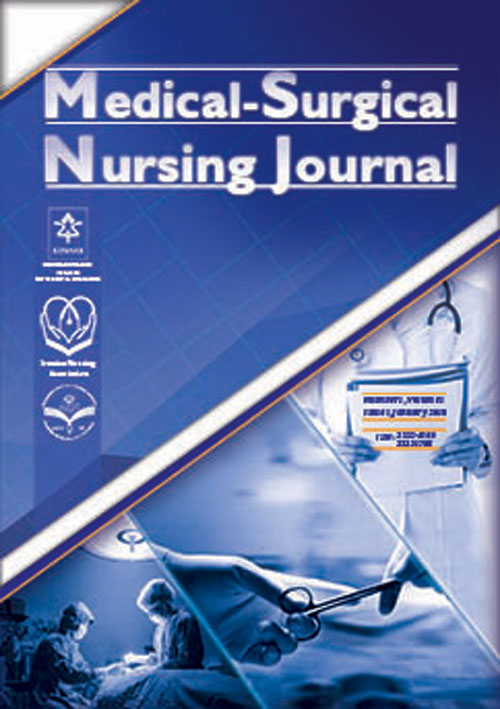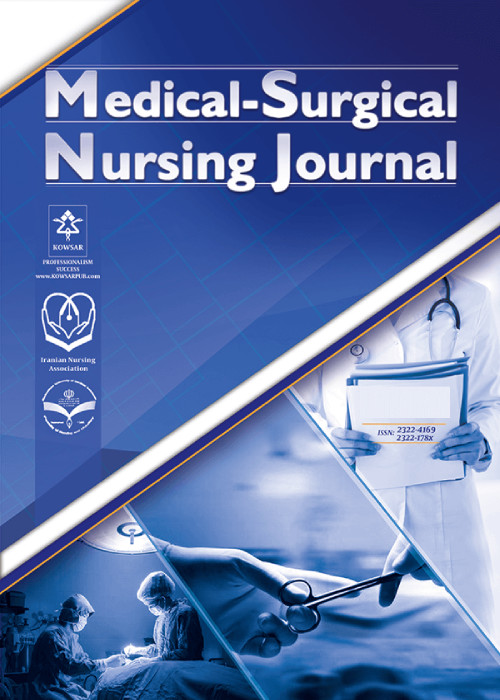فهرست مطالب

Iranian Journal Of Medical - Surgical Nursing
Volume:8 Issue: 2, May 2019
- تاریخ انتشار: 1398/04/01
- تعداد عناوین: 7
-
-
Page 1BackgroundResilience has become a basic construct in theories and studies of welfare and mental health. The mother is the one most involved emotionally in the child’s cancer and its treatment and hence, she requires the most degree of resilience. Therefore, it is crucial to deploy effective methods to enhance the resilience of mothers.ObjectivesThe purpose of this study was to determine the impact of peer education on the resilience of mothers of children with leukemia.MethodsThis clinical trial was performed on 74 mothers of children with leukemia who had been hospitalized in the hematology ward of Ali ibn Abi Talib Hospital in Zahedan in 2017. Convenience sampling was used to recruit the participants in accordance with the inclusion criteria. The subjects were randomly assigned to the control and experimental groups. Peer group training was then conducted for the experimental group for five days. The Connor-Davidson Resilience Scale (CD-RISC) was completed for both groups before and immediately after the intervention, as well as two months later. The data were then analyzed using the chi-square test (Fisher’s exact test), independent t-test, repeated measures ANOVA, and Bonferroni post hoc test at the significance level of P < 0.05.ResultsThe results showed that the mean total score of resilience and its subscales did not make a significant difference between the control and experimental groups immediately after the intervention (P > 0.05). Meanwhile, two months post-intervention, a significant difference was observed in this regard between the control and experimental groups, with the latter featuring a higher mean score (P < 0.001). Besides, the results suggested a significant increase in the total score of resilience and all its subscales over time in the experimental group (P < 0.001).ConclusionsPeer education could be implemented as an inexpensive easy method to improve the resilience of mothers of children with leukemia.Keywords: Peer Education, Resilience, Children, Mothers, Leukemia
-
Page 2BackgroundThe insertion of intravenous (IV) line is one of the most painful procedures in pediatric wards, which can lead to complications such as changes in the physiological parameters of the patient.ObjectivesThe purpose of this study was to determine the impact of a hand massage on controlling changes in the physiological parameters caused by inserting IV line in children.MethodsThis clinical trial was conducted in the Surgery Ward of a teaching pediatric hospital in Tabriz between 2016 and 2017. A total of 70 qualified children were enrolled and randomly assigned to the experimental and control groups. The experimental group underwent massage therapy five minutes before venipuncture until it was completed. Physiological responses of both groups were measured and recorded before and immediately after the intervention. Eventually, the data were analyzed in SPSS version 24 using descriptive (mean and standard deviation) and analytical (independent and paired t-tests) statistics.ResultsThe results of statistical analysis revealed that the increase in heart rate in response to the pain caused by venipuncture is significantly lower in the massage group than in the control group (P = 0.001).ConclusionsA hand massage is an easy, inexpensive, and practical technique that could be administered along with other pharmaceutical or non-pharmaceutical methods to control physiological responses of pain due to IV line insertion in children.Keywords: Hand Massage, Physiological Responses, Intravenous Line Insertion, Children
-
Page 3BackgroundBlood, injection, and injury (BII) phobia is one of the most common psychiatric disorders based on the criteria introduced in DSM-IV (fourth edition). Given the lack of a Persian instrument for BII phobia examination and the absence of accurate data on this type of phobia in the Iranian population, it is essential to assess the fear of BII in order to analyze and help mitigate BII phobia across the country.ObjectivesThe aim of this study was to investigate the psychometric properties of the Persian version of blood/ injection fear scale (BIFS-PV) in a sample of the Iranian population.MethodsIn this descriptive cross-sectional study, 246 patients (aged ≥ 14 years) referring to Kowsar Hospital, Semnan, were selected through convenience sampling. The research instruments included a demographic questionnaire, BIFS, blood-injection symptom scale (BISS), fear savory scale-III (FSS-III), and life orientation test (LOT). IBM SPSS Statistics 21.0 and IBM SPSS Amos 21 were used to analyze the data.ResultsBased on the results, the correlation coefficients of BIFS with BISS and FSS-III were -0.41 and -0.24, respectively, indicating convergent validity of BIFS. The correlation of BIFS with LOT was 0.37, suggesting the divergent validity of the scale. Factor analysis confirmed the appropriate fitting of the two-factor model of BIFS-PV with available data. Furthermore, examining the psychometric properties of BIFS-PV established internal consistency of the total scale (0.96) and its injection subscale (0.95) and blood subscale (0.91). Moreover, the test-retest reliability coefficients of BIFS-PV and its injection and blood subscales were 0.86, 0.90, and 0.91, respectively.ConclusionsThe results of the study corroborated the factor structure and validity of BIFS-PV in the study population. Therefore, this scale can be implemented as an effective tool in psychological research.Keywords: Blood, Injection, Phobia, Psychometric
-
Page 4ObjectivesNurses, as the largest group providing health care services, play a critical role in the continuity of care and respond to services commensurate with their competence. Professional competence in nursing is a complex and ambiguous concept and needs the redefinition of competence and development of its definition and concept. In this study, we aimed to conceptually analyze professional competence in nursing.MethodsIn this study, a hybrid concept analysis was used. In the literature review phase, the concept of ‘competence’ was investigated through valid databases limited to 2000 - 2018 and the participants’ experiences also appeared in the fieldwork phase. In the fieldwork phase, the participants revealed some aspects of professional competence in nursing, which were not well-addressed in the literature. Finally, the comprehensive definition of professional competence in nursing was presented after integrating the findings obtained in these two phases.ResultsAccording to the findings, professional competence in nursing is a combined, complex, multidimensional, and context-dependent concept, and consists of different domains. Based on the analysis results of the fieldwork phase, this concept was classified into 16 domains and the participants largely contributed to the provision of a comprehensive definition based on the definitions of professional competence presented in the literature.ConclusionsBased on the domains of professional competence in nursing obtained from this study, an appropriate instrument can be developed to assess professional competence in nursing for students and nurses.Keywords: Professional Competence, Nursing, Qualitative Research
-
Page 5BackgroundOne of the common complications of renal failure in hemodialysis patients which has a negative impact on quality of life is anemia. Various studies showed that cold hemodialysis could improve hemodialysis complications such as pruritus, sleep disorders and fatigue.ObjectivesThe aim of this study was determine the effect of cold hemodialysis on hemoglobin and hematocrit level in hemodialysis patients.MethodsThis research was a double-blind crossover randomized clinical trial study. 42 hemodialysis patients were divided into two groups (22 in the first group and 20 in the second group). The first group received standard hemodialysis temperature (fluid 37°C) in the first four weeks and simultaneously the second group received cold hemodialysis (fluid 35°C), in the second phase, four weeks later, the type of hemodialysis was changed in two groups. During the study, hemoglobin and hematocrit levels of patients were measured several times.ResultsThe results showed that in the first and second groups respectively, 55 and 32 percent of patients were in the age range of 50 - 65 years. Hemoglobin and hematocrit levels before the study in the two groups was not statistically significant (P: 0.19). But after the first four weeks, the mean of hemoglobin in the cold and standard hemodialysis were 13.85 vs. 11.9 and hematocrit 43.83 vs. 38.02, respectively and after the second four weeks the average hemoglobin in the cold and standards hemodialysis were 13.57 vs. 11.47, respectively and hematocrit 43.29 vs. 37.18. Crossover outcomes of the groups’ analysis showed that cold hemodialysis significantly increased hemoglobin and hematocrit levels in hemodialysis patients (P < 0.001).ConclusionsThe mean of hemoglobin and hematocrit was different between two groups and significantly higher in cold hemodialysis.Keywords: Anemia, Cold Hemodialysis, End Stage Renal Disease, Hemoglobin
-
Page 6BackgroundNon-adherence to treatment regimens can bring about negative effects on the quality of life of hemodialysis patients.ObjectivesThe present study was conducted to explore the relationship between compliance with treatment regimens and the quality of life in these patients.MethodsThis descriptive-analytic study investigated 68 hemodialysis patients who had referred to Imam Khomeini Hospital of Zabol, Southeast of Iran. The subjects were chosen via convenience sampling. Data were collected using a demographic questionnaire, a self-constructed scale for treatment regimen compliance, and the kidney disease quality of life short form (KDQOL-SF). Descriptive statistics, Pearson correlation coefficient, and t-test were used to analyze the data by SPSS 22.ResultsThe results showed that 77% of patients moderately adhered to treatment regimens, and the mean quality of life in hemodialysis patients was 56.36 ± 17.41. Pearson correlation coefficient revealed a positive significant relationship between the quality of life and compliance with treatment regimens in the study population (P = 0.02).ConclusionsAccording to the findings of this study, it is recommended that appropriate educational programs should be designed to improve the quality of life in hemodialysis patients by encouraging their adherence to treatment regimens.Keywords: Treatment Regimen Compliance, Quality of Life, Hemodialysis, End-Stage Renal Disease
-
Page 7BackgroundThe pain caused by wound dressing is common in burn patients. Using respiratory techniques is one of the non-pharmacological methods of pain control that has remained understudied in burn patients.ObjectivesThe aim of this study was to probe the effect of regular smooth breathing on the pain induced by dressing change in patients with second-degree burns.MethodsThis clinical trial was performed on 30 qualified patients with second-degree burns. The subjects were chosen through random sampling and assigned to experimental (n = 15) and control (n = 15) groups. The respiratory intervention was carried out in four dressing change sessions for the experimental group while the control group received only the routine care. The data were collected using a demographic questionnaire and a visual analog scale (VAS) for measuring pain intensity. The results were subsequently analyzed in SPSS 23 using the chi-square test, Fisher-exact test, and independent t-test.ResultsPain intensity after dressing was significantly lower in experimental group than control group in all four dressing sessions (P < 0.05).ConclusionsRegular smooth breathing reduces the pain caused by dressing burn injuries. Therefore, this intervention is recommended for burn patients.Keywords: Regular Smooth Breathing, Burn, Pain Associated with Dressing Change


